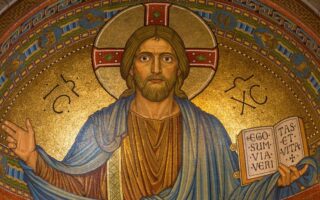An altar cloth in the Catholic Church is a piece of fabric that covers the altar during Mass. It is typically made of linen or other fine material and is used to protect the altar from spills and stains. The altar cloth is also used to symbolize the purity and sanctity of the altar, which is considered the most sacred part of the church.
Table of Contents
Symbolism of Altar Cloths in Catholic Church
Altar cloths are an essential part of the Catholic Church’s liturgical practices. These cloths are used to cover the altar during Mass and other religious ceremonies. But what exactly is the significance of altar cloths in the Catholic Church?
Altar cloths have a long history in the Catholic Church, dating back to the early days of Christianity. In the early Church, altars were often made of wood or stone and were covered with simple cloths. Over time, the use of altar cloths became more elaborate, with different colors and designs being used to symbolize different aspects of the faith.
One of the most common colors used for altar cloths is white. White is often used to symbolize purity and holiness, reflecting the belief that the altar is a sacred space where the Eucharist is celebrated. White altar cloths are typically used during the Easter season and other major feasts of the Church.
In addition to white, altar cloths may also be made in other colors, each with its own symbolic meaning. For example, red altar cloths are often used on feast days of martyrs and other saints, symbolizing the blood shed for the faith. Green altar cloths are used during Ordinary Time, symbolizing growth and renewal. Blue altar cloths are sometimes used during Advent and Lent, symbolizing hope and penance.
Altar cloths may also be adorned with intricate designs and symbols that hold special meaning for the Catholic Church. For example, some altar cloths may feature the Chi-Rho symbol, which is a monogram of the first two letters of the Greek word for Christ. This symbol is often used to represent Jesus Christ and his sacrifice on the cross.
Another common symbol found on altar cloths is the Lamb of God, which represents Jesus as the sacrificial lamb who takes away the sins of the world. This symbol is often used during the celebration of the Eucharist, where Catholics believe that the bread and wine become the body and blood of Christ.
Altar cloths are not only decorative but also serve a practical purpose in the Catholic Church. They help to protect the altar from spills and stains during Mass and other ceremonies. In addition, altar cloths are often used to cover the tabernacle, where the consecrated hosts are kept, as a sign of reverence and respect.
Overall, altar cloths play a significant role in the liturgical practices of the Catholic Church. They serve as a visual reminder of the sacredness of the altar and the Eucharist, as well as a symbol of the faith and traditions of the Church. Whether simple or elaborate, altar cloths are an important part of Catholic worship and help to create a sense of reverence and awe in the celebration of the Mass.
History and Evolution of Altar Cloths
Altar cloths have been an integral part of Catholic Church tradition for centuries. These cloths play a significant role in the celebration of the Eucharist and other sacraments. But what exactly is an altar cloth, and how has it evolved over time?
In the early days of the Catholic Church, altar cloths were simple pieces of fabric used to cover the altar during Mass. These cloths were typically made of linen or other fine materials and were meant to protect the altar from any spills or stains. Over time, altar cloths began to take on a more symbolic meaning, representing the purity and sanctity of the Eucharist.
As the Church grew and developed, so too did the altar cloths. They became more elaborate and ornate, often featuring intricate embroidery or designs. These cloths were seen as a way to beautify the altar and enhance the worship experience for the faithful.
One of the most common types of altar cloths used in the Catholic Church is the corporal. This cloth is placed on the altar during the celebration of the Eucharist and is used to hold the consecrated host and wine. The corporal is typically white, symbolizing the purity of Christ’s body and blood.
Another type of altar cloth is the pall, which is placed over the chalice during Mass. The pall is usually made of stiffened linen or silk and is meant to prevent any particles from falling into the chalice. Like the corporal, the pall is also white, symbolizing the purity of the Eucharist.
In addition to the corporal and pall, there are also other types of altar cloths used in the Catholic Church. The purificator is a small cloth used to wipe the chalice after communion, while the lavabo towel is used by the priest to dry his hands during Mass. These cloths all serve a specific purpose in the celebration of the sacraments and are considered essential to the liturgy.
Altar cloths have continued to evolve over time, reflecting changes in Church tradition and practice. While some parishes still use traditional linen cloths, others have begun to incorporate more modern materials and designs. Some altars now feature cloths made of silk or other luxurious fabrics, adorned with intricate patterns or symbols.
Despite these changes, the symbolic significance of altar cloths remains unchanged. They continue to represent the purity and sanctity of the Eucharist, serving as a visual reminder of Christ’s presence in the Mass. Whether simple or ornate, altar cloths play a vital role in the worship life of the Catholic Church.
In conclusion, altar cloths have a long and rich history in the Catholic Church. From their humble beginnings as simple pieces of fabric to their current role as symbols of the Eucharist, these cloths have played a vital role in the celebration of the sacraments. As the Church continues to evolve, altar cloths will undoubtedly continue to adapt and change, but their essential significance will remain unchanged.
Importance of Altar Cloths in Catholic Liturgy

Altar cloths play a significant role in the Catholic Church, serving as an essential part of the liturgical celebration. These cloths are not just mere decorations but hold a deeper meaning and symbolism that adds to the reverence and sanctity of the Mass.
In the Catholic tradition, the altar cloth is used to cover the altar, the sacred table where the Eucharist is celebrated. It is a symbol of purity and reverence, signifying the sacredness of the altar and the importance of the Eucharistic celebration. The use of altar cloths dates back to ancient times when they were made of fine linen or silk and adorned with intricate designs and symbols.
The color of the altar cloth also holds significance in the Catholic liturgy. Different colors are used to reflect the liturgical season or feast being celebrated. For example, white is used during the Christmas and Easter seasons to symbolize purity and joy, while red is used on Pentecost and other feasts of martyrs to symbolize the blood of Christ and the sacrifice of the martyrs.
Altar cloths are also used to cover the chalice and paten, the vessels used to hold the wine and bread during the Eucharistic celebration. This practice dates back to the early Church when the chalice and paten were covered with a cloth to protect them from dust and insects. Today, the use of altar cloths to cover the chalice and paten serves as a sign of reverence and respect for the sacred vessels used in the Mass.
The care and handling of altar cloths are also important in the Catholic Church. Altar cloths are considered sacred objects and should be treated with respect and reverence. They should be kept clean and free from stains, as any impurities on the altar cloth can detract from the sanctity of the Mass. Altar cloths should be washed and ironed regularly to ensure they are in good condition for use during the liturgical celebrations.
Altar cloths are also used to adorn the altar during special feasts and celebrations in the Catholic Church. They are often embroidered with symbols and designs that reflect the liturgical season or feast being celebrated. These decorative altar cloths add to the beauty and solemnity of the Mass, creating a sense of reverence and awe for the Eucharistic celebration.
In conclusion, altar cloths play a vital role in the Catholic liturgy, serving as symbols of purity, reverence, and respect for the Eucharistic celebration. The use of altar cloths dates back to ancient times and continues to be an essential part of the Catholic tradition. Altar cloths are not just mere decorations but hold a deeper meaning and symbolism that adds to the beauty and sanctity of the Mass. So next time you attend Mass, take a moment to appreciate the altar cloth and the significance it holds in the Catholic Church.
Different Types and Colors of Altar Cloths
Altar cloths play a significant role in the Catholic Church, adding beauty and symbolism to the celebration of the Eucharist. These cloths cover the altar, the sacred table where the bread and wine are consecrated during Mass. They come in various types and colors, each with its own meaning and significance.
One of the most common types of altar cloths is the corporal. This square cloth is placed on the center of the altar, where the chalice and paten rest during the consecration. The corporal is typically white, symbolizing purity and the body of Christ. It is folded in a specific way after Mass to ensure that any particles of the consecrated host are properly cared for and not desecrated.
Another type of altar cloth is the pall, which covers the chalice during Mass. The pall is usually made of stiffened linen or silk and is often decorated with a cross or other religious symbols. The pall serves to protect the Eucharistic elements from dust and insects, as well as to symbolize the shroud that covered Christ in the tomb.
The fair linen is a larger cloth that covers the entire top of the altar. It is typically white, symbolizing the purity of Christ and the Church. The fair linen is often embroidered with crosses or other religious symbols, adding beauty and reverence to the altar.
In addition to these common types of altar cloths, there are also seasonal and special occasion cloths that are used throughout the liturgical year. For example, during Advent and Lent, purple altar cloths are used to symbolize penance and preparation. During Easter and Christmas, white and gold altar cloths are used to symbolize joy and celebration. On feasts of martyrs, red altar cloths are used to symbolize the blood of the martyrs.
Altar cloths are not only beautiful decorations but also serve a practical purpose in the celebration of the Eucharist. They help to create a sacred space for the consecration of the bread and wine, as well as to protect the Eucharistic elements from harm. Altar cloths are an important part of the rich tradition of the Catholic Church and add to the reverence and beauty of the Mass.
In conclusion, altar cloths are an essential part of the Catholic Church’s liturgical tradition. They come in various types and colors, each with its own meaning and significance. Altar cloths add beauty and symbolism to the celebration of the Eucharist, creating a sacred space for the consecration of the bread and wine. Whether white for purity, purple for penance, or red for martyrdom, altar cloths play a vital role in enhancing the reverence and beauty of the Mass.
How Altar Cloths are Used in Catholic Church Services
Altar cloths are an essential part of Catholic Church services, but what exactly are they and why are they used? Altar cloths are pieces of fabric that cover the altar in a church. They come in various colors and designs, but their main purpose is to symbolize purity and reverence for the Eucharist, which is the central focus of Catholic worship.
During Mass, the altar cloth serves as a backdrop for the celebration of the Eucharist. It is a symbol of the table where Jesus shared the Last Supper with his disciples, and where the bread and wine are consecrated during the Mass. The altar cloth is a reminder of the sacredness of the Eucharist and the importance of the altar as the focal point of worship.
Altar cloths are typically made of linen, a material that is considered pure and unblemished. Linen is also used to make the corporal, which is a square piece of cloth placed on the altar to hold the consecrated bread and wine during the Eucharistic prayer. The corporal is then folded and placed in the chalice after communion, symbolizing the burial of Christ.
In addition to the corporal, altar cloths may also include a pall, which is a stiffened square of fabric placed over the chalice to prevent any particles of the consecrated bread and wine from falling onto the altar. The pall is a symbol of the shroud that covered Christ’s body in the tomb.
Altar cloths are changed according to the liturgical season and feast days of the Church. The color of the cloth reflects the mood and theme of the celebration. For example, white is used during Christmas and Easter to symbolize joy and purity, while purple is used during Lent to symbolize penance and preparation. Red is used on Pentecost and other feast days to symbolize the Holy Spirit, and green is used during Ordinary Time to symbolize growth and renewal.
Changing the altar cloth is a ritual that is performed with care and reverence. The old cloth is removed and replaced with a new one, which is then carefully smoothed and arranged on the altar. This ritual is a symbol of the changing seasons of the Church year and the continuous cycle of death and resurrection.
Altar cloths are not just decorative items in the Catholic Church; they are symbols of the sacredness of the Eucharist and the importance of the altar as the focal point of worship. They remind us of the Last Supper and the sacrifice of Christ on the cross. They are a visual representation of the mystery and beauty of the Catholic faith.
In conclusion, altar cloths play a vital role in Catholic Church services. They symbolize purity, reverence, and the centrality of the Eucharist in Catholic worship. They are changed according to the liturgical season and feast days of the Church, reflecting the mood and theme of the celebration. Altar cloths are not just pieces of fabric; they are symbols of the sacredness and beauty of the Catholic faith.
Conclusion
An altar cloth in the Catholic Church is a piece of fabric that covers the altar during Mass. It is typically white and is used to symbolize purity and reverence for the Eucharist. The altar cloth is an important part of the liturgical tradition in the Catholic Church and is often adorned with intricate designs and symbols.


